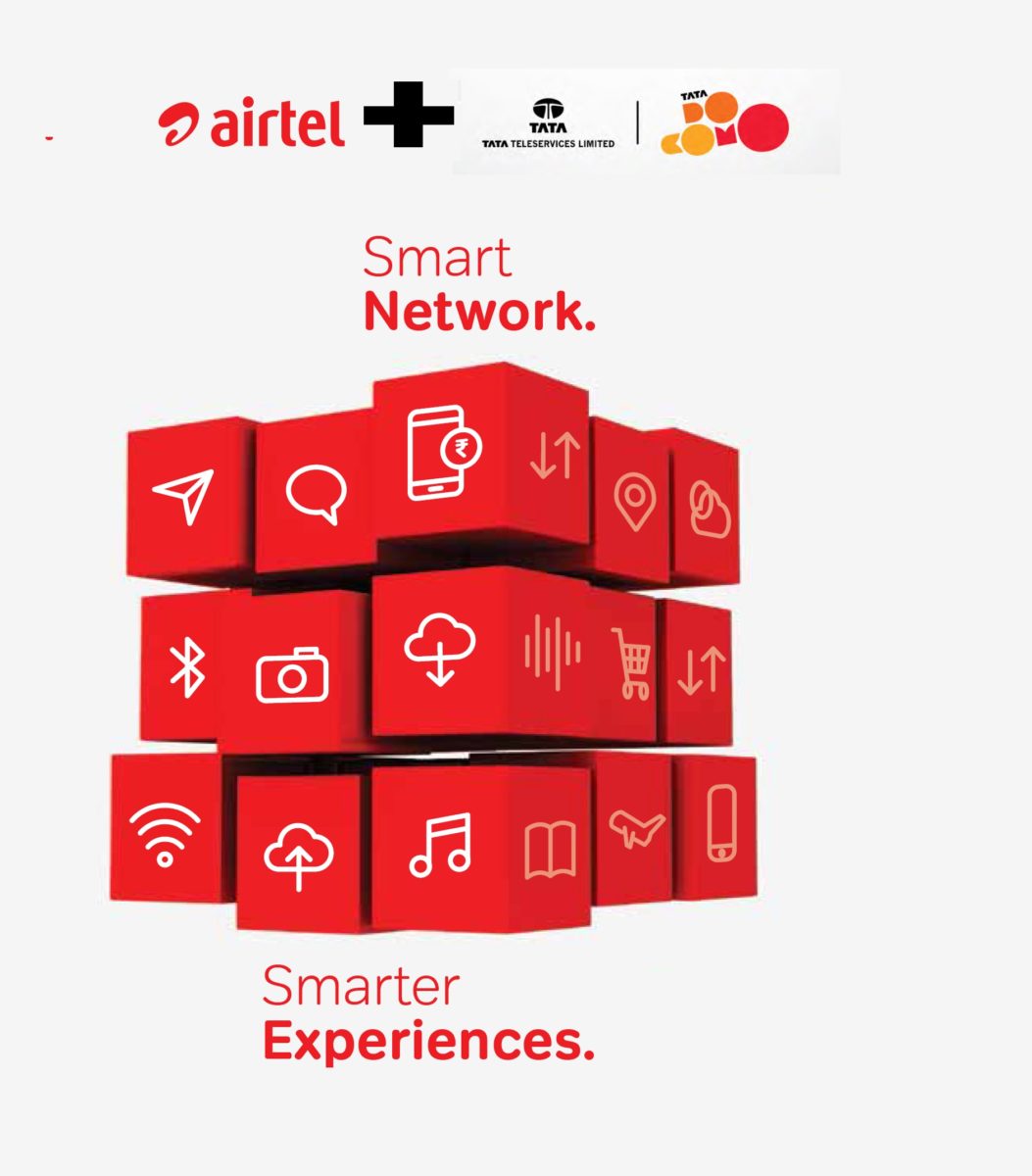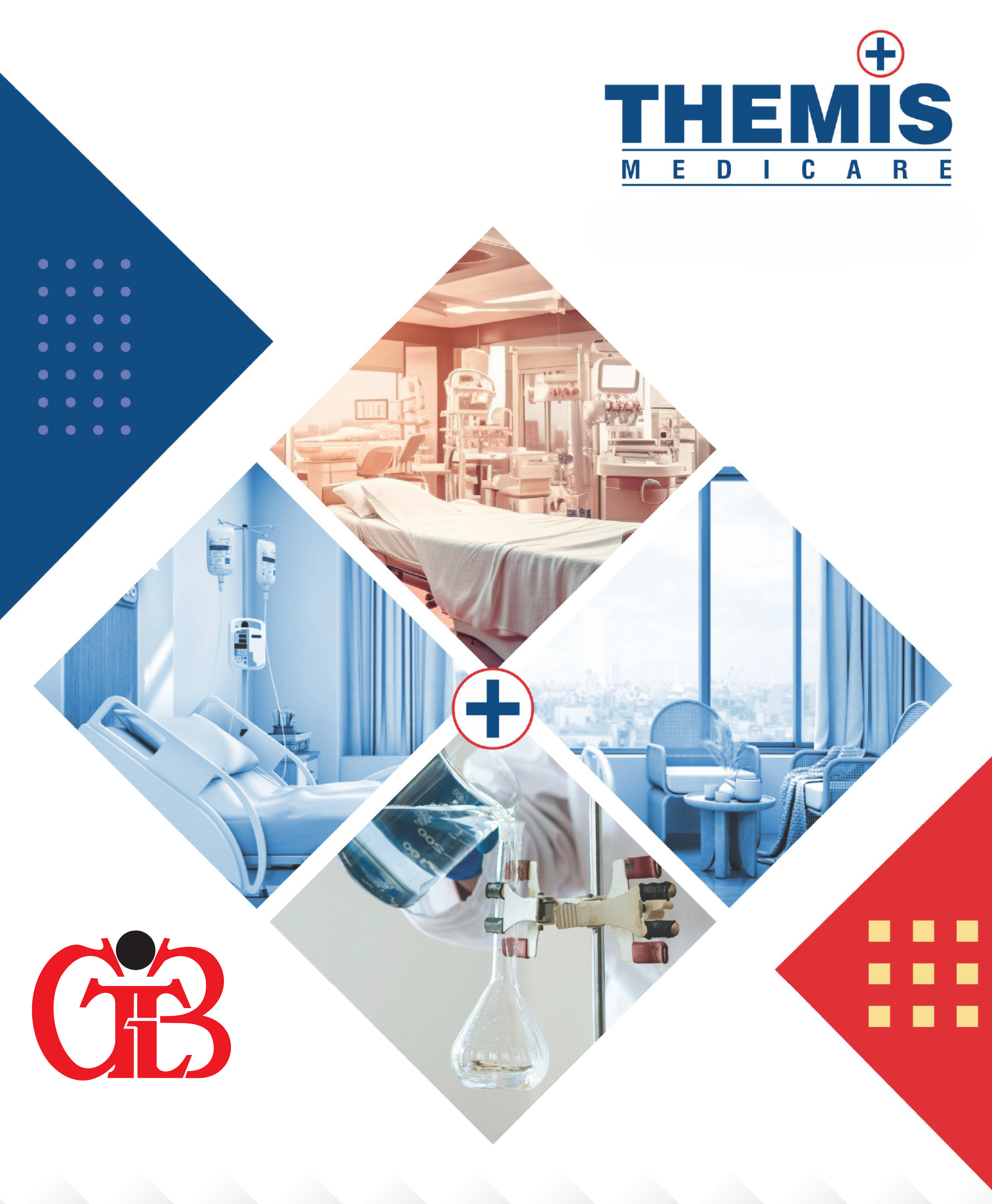Tata Teleservices Limited (TTSL) and Tata Teleservices Maharashtra (TTML), together referred to as Tata, to combine their Consumer Mobile Businesses (CMB) with Bharti Airtel
- Tata CMB to merge with Bharti Airtel.
- Over 40 million customers to join Bharti Airtel and benefit from state-of-the-art 4G mobile network, with fall back on its 3G and 2G ecosystem.
- Merger on a debt-free, cash-free basis.
- All past liabilities and dues to be settled by Tata.
- Bharti Airtel will assume a small portion of the unpaid spectrum liability of Tata.
- Merger to bolster Bharti Airtel’s pre-eminent spectrum pool, with significant additional spectrum in 1,800, 2,100 and 850 MHz bands, all widely used for 4G.
- Transaction will also provide Bharti Airtel right to use Tata’s existing fibre network.
- Merger of TTL’s customers and revenue base will further strengthen Bharti Airtel’s Revenue Market Share (RMS).
- Tata to retain its stake in Viom and take care of associated liabilities.
- The merger is being done on a debt-free, cash-free basis, except for Bharti Airtel assuming a small portion of the unpaid spectrum liability of Tata’s towards the DoT, which is to be paid on a deferred basis.
Structure of the transaction
The transaction is a Slump Sale of The CMB undertaking. [Section 2(42C) of the Income Tax Act, 1961] Undertaking includes any part of the undertaking or a unit or division of the undertaking or a business activity as a whole but does not include individual assets or liabilities or any combination thereof not constituting a business activity
Firstly from the side of Companies Act,2013
Section 180. (1) The Board of Directors of a company shall exercise the following powers only with the consent of the company by a special resolution, namely:—
- to sell, lease or otherwise dispose of the whole or substantially the whole of the undertaking of the company or where the company owns more than one undertaking, of the whole or substantially the whole of any of such undertakings.
Explanation.—for the purposes of this clause,—
(i) “undertaking” shall mean an undertaking in which the investment of the company exceeds twenty percent of its net worth as per the audited balance sheet of the preceding financial year or an undertaking which generates twenty per cent. of the total income of the company during the previous financial year;
The boards of TTSL and TTML have approved this transaction. Before the transaction gets operationalised, the approval of the shareholders of TTSL and TTML through a special resolution as required under section 180(1) of the Companies Act,2013 shall be obtained
Restrictions on ‘Transfer of License’
-
- The Licensee shall not, without the prior written consent of the Licensor as described below, either directly or indirectly, assign or transfer this License in any manner whatsoever to a third party or enter into any agreement for sub-License and/or partnership relating to any subject matter of the License to any third party either in whole or in part i.e. no sub-leasing/partnership/third party interest shall be created. For provision of the service by the Licensee, the Licensee may appoint or employ franchisee, agents, distributors and employees.
- Further, the Licensee may transfer or assign the License Agreement with prior written approval of the Licensor, in the following circumstances, and if otherwise, no compromise in competition occurs in the provisions of Telecom Services:-
- (a): When transfer or assignment is requested in accordance with the terms and conditions on fulfilment of procedures of Tripartite Agreement if already executed amongst the Licensor, Licensee and Lenders; or
- (b): Whenever amalgamation or restructuring i.e. merger or demerger is sanctioned and approved by the High Court or Tribunal as per the law in force; in accordance with the provisions; more particularly Sections 391 to 394 of Companies Act, 1956 [more particularly Sections 230 to 232 of the Companies Act 2013];Provided that scheme of amalgamation or restructuring is formulated in such a manner that it shall be effective only after the written approval of the Licensor for transfer/merger of Licenses, and
- Prior written consent/No Objection of the Licensor has been obtained for transfer or merger of Licenses as per applicable guidelines issued from time to time.Further, the transferee/assignee is fully eligible in accordance with eligibility criteria as applicable for grant of fresh License in that area and show its willingness in writing to comply with the terms and conditions of the License agreement including past and future roll-out obligations as well as to comply with guidelines for transfer/merger of Licenses including for charges as applicable; and
- All the past dues are fully paid till the date of transfer/assignment by the Transferor Company and Transferee Company, and thereafter the transferee company undertakes to pay all future dues inclusive of anything remained unpaid of the past period by the outgoing company.
| Sl. No | Compliance requirements under license agreement |
| 1 | Prior approval of TRAI for the Understanding (agreement) to transfer the CMB business under condition 6.4 of the agreement |
| 2 | Shareholder special resolution from each of the TTSL and TTML general meeting of shareholders |
| 3 | NCLT order under section 232 of the Companies Act 2013 approving the reconstruction through transfer of undertaking |
Rights of Secured creditors
Rights of Secured creditors who have a security interest over the property of the undertaking that is now subject to the Understanding(agreement). The rights of the Secured Creditors like Banks and Financial Institutions are protected under Recovery of Debts due to Banks and Financial Institutions Act 1993
Under CHAPTER IV – PROCEDURE OF TRIBUNALS – Section 19. Application to the Tribunal.—
Where a bank or a financial institution has to recover any debt from any person, it may make an application to the Tribunal within the local limits of whose jurisdiction
- the defendant, or each of the defendants where there are more than one, at the time of making the application, actually and voluntarily resides or carries on business or personally works for gain; or
- any of the defendants, where there are more than one, at the time of making the application, actually and voluntarily resides or carries on business or personally works for gain; or
- The cause of action, wholly or in part, arises.
RECOVERY OF DEBT
The written statement shall have the same effect as a plaint in a cross-suit so as to enable the Tribunal to pass a final order in respect both of the original claim and of the set-off.
CHAPTER V RECOVERY OF DEBT DETERMINED BY TRIBUNAL Section 25.
Modes of recovery of debts.—The Recovery Officer shall, on receipt of the copy of the certificate under sub-section (7) of section 19, proceed to recover the amount of debt specified in the certificate by one or more of the following modes, namely:-
- attachment and sale of the movable or immovable property of the defendant;
- arrest of the defendant and his detention in prison;
- Appointing a receiver for the management of the movable or immovable properties of the defendant.
Transfer of Property Act 1882
- The mortgagee (Banks and FIs) have the right under section 67 – right to obtain from the court an order that the mortgagor shall be absolutely debarred of his right to redeem the property or an order that the property be sold and 68 – right to sue the mortgagor for recovery of the mortgaged money where by any cause other than the wrongful act of the mortgagor or mortgagee, the security has become insufficient as defined under section 66 and the mortgagee has given 6 months to the mortgagor to provide another security in the absence of which he can sue the mortgagor for the mortgage money -of the Transfer of Property Act 1882.
- In the understanding, the liabilities of Rs 40,000 crore will not be taken over by Bharti and need to be managed and repaid by Tata Teleservices. In that context, the transfer of the Consumer Mobile Business as an undertaking would mean that the underlying assets over which the secured creditors have a security interest will lose the security.
- They need to be either settled or secured by alternative security as contemplated under section 69 of the TP Act 1882.
- in a beneficial position than it would have been in the event of a distribution of assets being made in accordance with section 53.
- Section 43 (3) For the purposes of sub-section (2), a preference shall not include the following transfers— (a) transfer made in the ordinary course of the business or financial affairs of the corporate debtor or the transferee;
- The transfer of the CMB business as an undertaking between TTSL and Bharti is not a transaction between a debtor and a financial creditor but a transaction made in the ordinary course of business between TTSL and Bharti. Hence the transaction is not hit by the provisions of section 43(2). It comes under the exclusions mentioned in section 43(3) (a).
The taxability under the Income Tax Act 1961- Slump Sale
- Under Section 50B. (1) Any profits or gains arising from the slump sale effected in the previous year shall be chargeable to income-tax as capital gains arising from the transfer of long-term capital assets and shall be deemed to be the income of the previous year in which the transfer took place.
- The current transaction is a Slump Sale. Hence the provisions of section 50B shall apply.
- The consideration received under the transaction is Zero. But the department may refer the transaction to a Valuation officer under section 55A who may have to provide the valuation as per Section 247(2) (c) of the Companies Act 2013 read with Rule 6 (Chapter XVII Registered Valuers) of the COMPANIES (REGISTERED VALUERS AND VALUATION) RULES, 2017.
- Section 247(2)(C ) provides for any one of the following valuation approaches:
- Asset approach
- Income approach
- Market approach
Finally under the provisions of GST, 2017
Under Chapter III, LEVY AND COLLECTION OF TAX, Section 7. (1) For the purposes of this Act, the expression “supply” includes––
(a) all forms of supply of goods or services or both such as sale, transfer, barter, exchange, licence, rental, lease or disposal made or agreed to be made for a consideration by a person in the course or furtherance of business;
(b) Import of services for a consideration whether or not in the course or furtherance of business;
(c) The activities specified in Schedule I, made or agreed to be made without a consideration; and
(d) The activities to be treated as supply of goods or supply of services as referred to in Schedule II
SCHEDULE I [See section 7] ACTIVITIES TO BE TREATED AS SUPPLY EVEN IF MADE WITHOUT CONSIDERATION. Permanent transfer or disposal of business assets where input tax credit has been availed on such assets.
Under Schedule II, Clause 4 requires special focus here as it talks about Transfer of a business:
Clause 4. Transfer of business assets
(a) where goods forming part of the assets of a business are transferred or disposed of by or under the directions of the person carrying on the business so as no longer to form part of those assets, whether or not for a consideration, such transfer or disposal is a supply of goods by the person;
(b) where, by or under the direction of a person carrying on a business, goods held or used for the purposes of the business are put to any private use or are used, or made available to any person for use, for any purpose other than a purpose of the business, whether or not for a consideration, the usage or making available of such goods is a supply of services;
(c) Where any person ceases to be a taxable person, any goods forming part of the assets of any business carried on by him shall be deemed to be supplied by him in the course or furtherance of his business immediately before he ceases to be a taxable person, unless—
- The business is transferred as a going concern to another person; or
- The business is carried on by a personal representative who is deemed to be a taxable person.
Section 9. (1) Subject to the provisions of sub-section (2), there shall be levied a tax called the central goods and services tax on all intra-State supplies of goods or services or both, except on the supply of alcoholic liquor for human consumption, on the value determined under section 15 and at such rates, not exceeding twenty per cent., as may be notified by the Government on the recommendations of the Council and collected in such manner as may be prescribed and shall be paid by the taxable person.
CHAPTER IV TIME AND VALUE OF SUPPLY
Section 12. (1) The liability to pay tax on goods shall arise at the time of supply, as determined in accordance with the provisions of this section. (2) The time of supply of goods shall be the earlier of the following dates, namely:—
(a) the date of issue of invoice by the supplier or the last date on which he is required, under sub-section (1) of section 31, to issue the invoice with respect to the supply; or
(b) The date on which the supplier receives the payment with respect to the supply:
Value of taxable supply
Section 15. (1) The value of a supply of goods or services or both shall be the transaction value, which is the price actually paid or payable for the said supply of goods or services or both where the supplier and the recipient of the supply are not related and the price is the sole consideration for the supply.
Thus the Transaction of Transfer of business undertaking as a Going concern will come under the exception provided under clause 4 (c) of Schedule II and hence shall escape from the provisions of GST. This is the view senior lawyers also take considering that the CMB business is sold as a going concern.
Let us analyse what is a Going Concern.
In exercise of the powers conferred by sub-section (2) of section 145 of the Income-tax Act, 1961 (43 of 1961), the Central Government hereby notifies the following accounting standards to be followed by all assessees following mercantile system of accounting, namely:—
Accounting Standard 1 relating to disclosure of accounting policies:
Under Clause 6 (e) of the above notification, “Going concern” refers to the assumption that the assessee has neither the intention nor the necessity of liquidation or of curtailing materially the scale of the business, profession or vocation and intends to continue his business, profession or vocation for the foreseeable future.
The subscribers and the underlying assets are transferred to Bharti while the liabilities are retained by TTSL. This is an unusual transaction where the assets/income earning source(subscribers) are transferred for free but the underlying liabilities are retained for settlement by the transferor.
Whether this is a transfer as a Going Concern is a matter of debate.
If it is concluded as a transfer of business assets as a Going Concern, then under clause 4(c ) of Schedule II to the CGST Act 2016, the transaction is excluded from being treated as a Transfer under Section 7(1) and hence shall not be liable to GST levy
On the other hand, if there is a doubt and the department takes the view that it is transfer under section 7(1) ( Response by the CBEC to FAQ no 70 treats the Slump Sale as any other normal supply), then it shall be levied at 18% under Heading 9984.
The FAQs issued by the GST council consider a Slump Sale as any transfer under the CGST Act. According to FAQs issued by CBEC
| Sl. No | Questions/Tweets received | Replies |
| 70 | Whether slump sale will attract GST. If yes then under which Section? | It will have the same treatment as normal supply. |
Conclusion
The merger is being done on a debt-free, cash-free basis, except for Bharti Airtel assuming a small portion of the unpaid spectrum liability of Tata’s towards the DoT, which is to be paid on a deferred basis.




